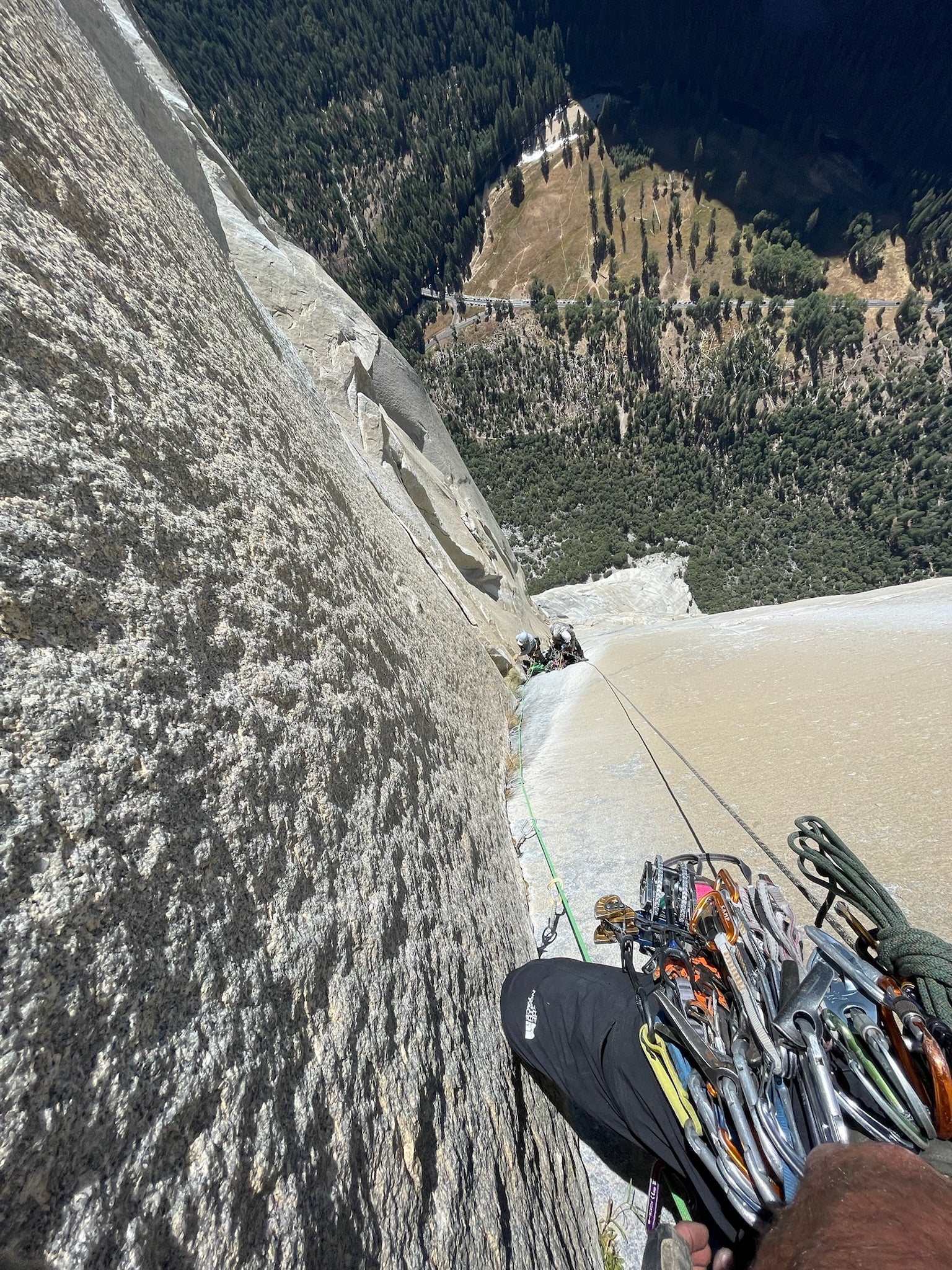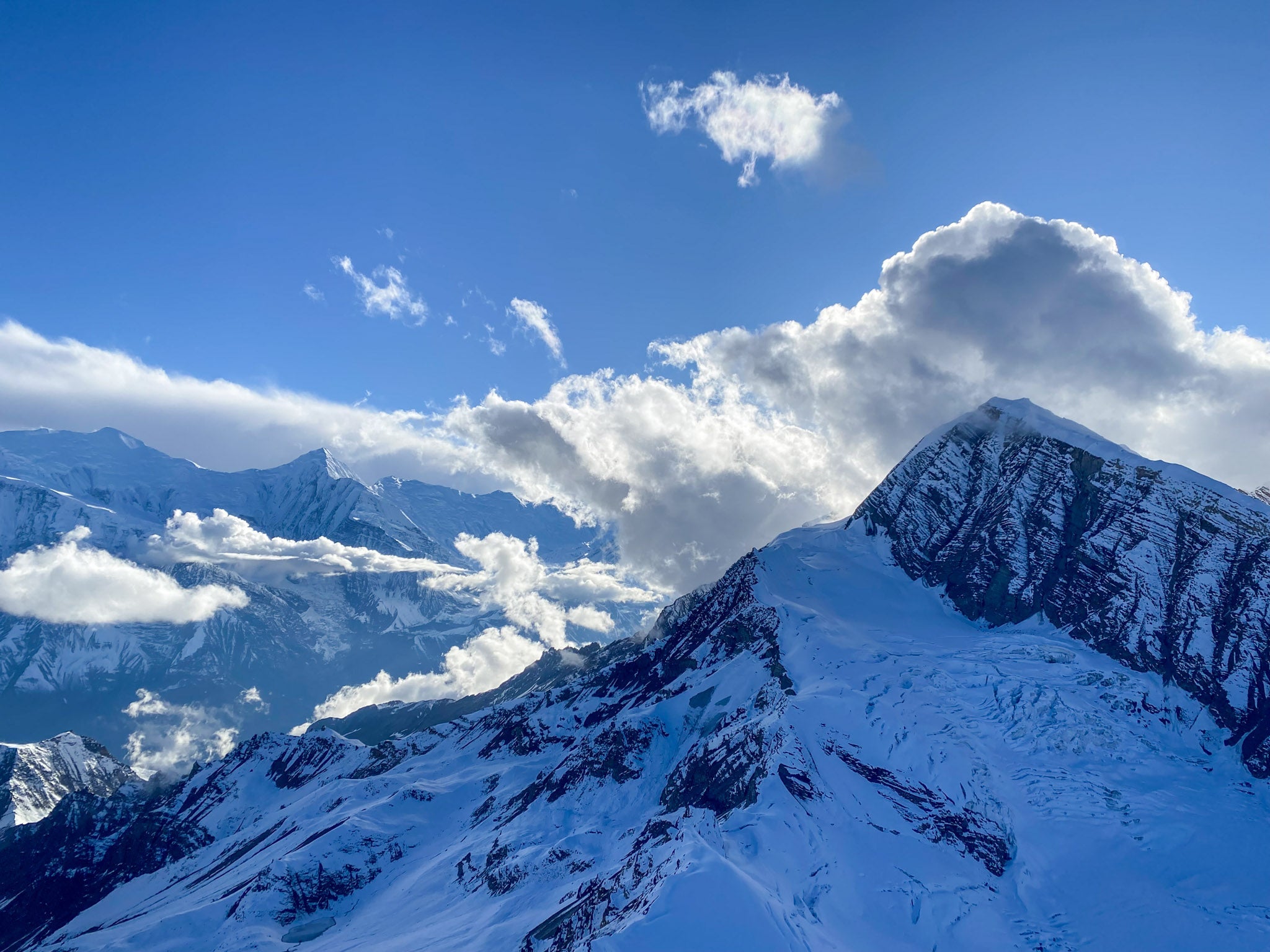Article: El Cap 2024: Horse Play Turns into Muir Wall

El Cap 2024: Horse Play Turns into Muir Wall

"The entire idea behind climbing El Cap in 2024 was to get Gerb his 42nd year in a row up the hill."
The entire idea behind climbing El Cap in 2024 was to get Gerb his 42nd year in a row up the hill. For the last two years, it has been the two longtime friends, Gerb and Griff, along with the clueless addition of myself. The two pros let me tag along on some radical vertical camping. This year was a bit different as Griff was unable to join the ascent. There was talk of another Sad Bird Team member joining the expedition, but due to time constraints and scheduling, he couldn’t make it. Next year! We needed to bring in another ringer. Gerb managed to convince Matt to join, and the crew was in place. Now all we needed was a route!
Gerb had been wanting to get on one of the only routes he hadn’t completed—the somewhat benign Horse Play, an A3 variation on the semi-classic Horse Chute. It was decided: dates, route, gear. We were set.
Instead of just completing the climb this year, I had a goal. I wanted to be a more active member of the team and had been working on my gear placements, rope work, and general climbing knowledge and experience. I went into this climb feeling like I was going to be a productive member of the team. Fully psyched. We were ready.
Every ascent I’ve done of El Cap has gone in phases. It starts with gear sorting and hauling gear to the base, fixing lines on the first few pitches, a rest day, and then blasting to the top. The plan was to meet on a Sunday morning in Yosemite Valley at the base of the Captain itself for the gear divvy and haul plan. Everyone drove up on Saturday night and planned to meet early Sunday morning. Someone slept in (me), so we didn’t actually get started until the sun was high in the sky. Once we divvied gear, scoped out the route, and had plenty of chit-chats, we started up to the base of Horse Play with the first haul.
On the first haul, we made it to the bottom of Horse Play. At the base, we saw several bags and ropes, indicating a team already on the route. Looking up confirmed it—less than two pitches in, a team was fixing lines. As it happens, Gerb is somewhat well-known in the valley. He gets along with most everyone—except maybe one guy. And, as luck would have it, this guy was on the route. Now, I can’t be certain, but I don’t believe it was by chance. I have no idea how he could have possibly known, but there he was. Instead of risking a weirdly contentious interaction, we flexed. Bring on the Muir Wall.
The Muir Wall is one of the oldest routes on El Cap, following obvious crack systems and moderate face climbing, finishing directly on the west side of the Nose. It boasts some of the most spectacular vistas and high-exposure pitches on the wall. At 30 pitches and almost 3,000 vertical feet, it’s one of the longer routes on the Captain. Fixing lines on the Muir isn’t typical; instead, we hauled all our gear to the Heart Ledges—a major interchange on the west face where several routes converge from the base and split to the top. It’s a hub for major and well-known routes like Freerider (from Free Solo fame), the notorious Shield Wall, and several others.
Hauling our bags to the Heart Ledges took an entire day due to the crowded nature of the route. Crowded, in this case, meant two other parties in sight. Even one other group on the lines slows everything down considerably. By the end of the long haul, we had all our gear almost 1,000 feet up and ready to start the climb.
The Muir has two variations for its start. We opted for the Freeblast start, which involves 10 pitches of moderate 5.11+ free climbing. Fortunately for us, we had a pro who could knock that out in a day, getting us all the way to the Heart Ledges where our food, water, and sleeping gear were stashed. We pushed up two more pitches, making it 12 pitches in one day. By Wednesday night, the party was together. We had a good meal and congratulated ourselves on making the progress we’d hoped for on the first real day of climbing. Eighteen pitches to go.
We started the second day of climbing in pure aid mode. Switching from free climbing to aid climbing slows things down… considerably.
"Thirteen pitches to go. This is where things got interesting..."

After every pitch, the bags must be hauled, the big wall anchors need to be set, the gear restowed and reorganized, and snacks consumed (I think I was the only one snacking, but to me, it was crucial). The lower pitches of the Muir go fairly quickly. The angle is relatively low, and the cracks are plentiful and wide. We weren’t in a major time crunch and figured that with 18 pitches left, we could finish in 3 or 4 days, topping out Saturday night or early Sunday. With high spirits and plenty of energy, we knocked out five pitches of routine climbing on the first day and fixed a sixth for the next morning. Short days—sunrise around 7 a.m. and sunset just after 5 p.m.—meant we had to move fast. Thursday night brought great sleep and great vibes. Thirteen pitches to go.
This is where things got interesting. The old pro brought a new inflatable ledge designed for high-altitude alpine environments where weight and space are critical. While lightweight and collapsible, it’s not the most stable or comfortable. This became evident when the old pro woke up grumpy and not exactly fired up for a full day of climbing. Coffee and camaraderie saved the day, though, and we turned his mood around. Day three was similar to day two: moderate climbing, cruising along. We knocked out another five pitches and felt good about our progress. By nightfall, we were split up—the young pro was a pitch ahead, solo, while the old pro and I were a pitch below. The vibes weren’t quite as high, but I was stoked to be almost 2,000 feet up, sleeping like a dream. The old pro was feeling a little worn. Eight pitches to go… and the rest was almost entirely straight up.
Day four of climbing! The view at this point was insane. We were paralleling the Nose, with the entire valley spread out to the east and west. Wedged in a corner that seemed to stretch endlessly upward, it felt like pure classic El Cap climbing. But it was harder. The pace slowed significantly. There were longer pauses between pitches, and the climbing took much more effort. Not a big deal with only eight pitches left, but it was a definite change in pace. We managed four glorious pitches but hoped for a fifth to make the summit day shorter. Unfortunately, darkness set in, and we spent another night separated—the young pro solo and the old pro and I relaxing with good food and good attitudes. Four pitches to the summit.
Summit Day! What a feeling to see the top, knowing the bags were lighter with all the food and water gone. The vertical cracks stretched endlessly above. Thinking about how Chouinard managed these features in the ’60s with far inferior gear was humbling. Even with modern gear, it felt intense.
That said, we ran into issues. The second-to-last pitch involved a serious traverse across a rough, broken face with many arêtes that snagged lines. Exhausted and eager to finish, we made a poor choice: attempting to pendulum the bags 200 feet across the face. Summit fever had set in, and it cost us hours to untangle ropes, rig a rappel from the summit, and lower back to retrieve the bags as the sun set.
But it was everything we had hoped for. As we pulled the last of the bags over the rim, tired, hungry, and frustrated by our mistakes, we were thrilled by our conquest of the Captain. Looking up, we saw a blaze streaking across the sky—a comet that might as well have been shouting “well done” in neon lights.
It reminded me how lucky I am to share my passions and love for life with amazing people. It’s easy to wake up and be alive, but it takes drive, desire, and sometimes five days on a cliff edge to truly live. Thanks to the pros, young and old, who push me to be better and continue to inspire my adventures.


